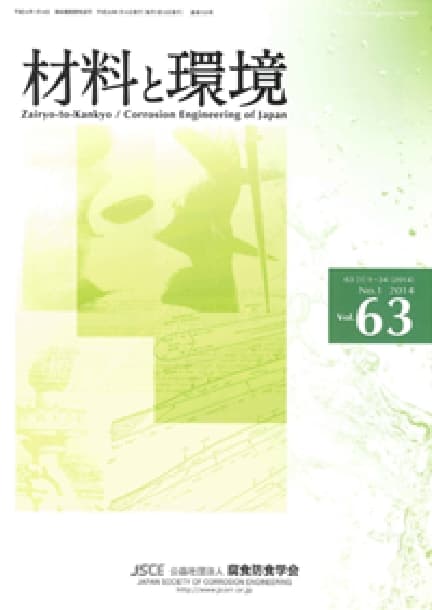材料と環境 Vol. 63 (2014), No. 10
Backnumber
-
Vol. 74 (2025)
-
Vol. 73 (2024)
-
Vol. 72 (2023)
-
Vol. 71 (2022)
-
Vol. 70 (2021)
-
Vol. 69 (2020)
-
Vol. 68 (2019)
-
Vol. 67 (2018)
-
Vol. 66 (2017)
-
Vol. 65 (2016)
-
Vol. 64 (2015)
-
Vol. 63 (2014)
-
Vol. 62 (2013)
-
Vol. 61 (2012)
-
Vol. 60 (2011)
-
Vol. 59 (2010)
-
Vol. 58 (2009)
-
Vol. 57 (2008)
-
Vol. 56 (2007)
-
Vol. 55 (2006)
-
Vol. 54 (2005)
-
Vol. 53 (2004)
-
Vol. 52 (2003)
-
Vol. 51 (2002)
-
Vol. 50 (2001)
-
Vol. 49 (2000)
-
Vol. 48 (1999)
-
Vol. 47 (1998)
-
Vol. 46 (1997)
-
Vol. 45 (1996)
-
Vol. 44 (1995)
-
Vol. 43 (1994)
-
Vol. 42 (1993)
-
Vol. 41 (1992)
-
Vol. 40 (1991)
キーワードランキング
22 Dec. (Last 30 Days)
材料と環境 Vol. 63 (2014), No. 10
マイクロインデンテーション法の不働態金属表面への適用
島田 隆登志
pp. 515-520
DOI:
10.3323/jcorr.63.515抄録
The micro-indentation technique was newly developed for investigating rupture and repair of passive films. The technique was applied to pure iron and aluminum surfaces. The rupture and repair behavior of the passive films was explained. It is clearly shown that rupture of passive films formed on the metal surface is affected by the mechanical properties including film thickness of and stress in the passive film.
250℃の高圧水素ガス中でのSUS304鋼の水素脆化感受性
小出 賢一, 南 孝男, 安樂 敏朗, 岩瀬 彰宏, 井上 博之
pp. 523-527
DOI:
10.3323/jcorr.63.523抄録
The hydrogen embrittlement susceptibility of SUS304 steel in high-pressure hydrogen (H2) gas at 250°C was studied using the slow strain rate testing (SSRT) in high-temperature and high-pressure H2 gas. In high-pressure H2 gas, SUS304 (UNS S30400) steel showed clear susceptibility to embrittlement at room temperature (RT), but very low one at 250°C, that was the same level with SUS316L (UNS S31603) steel at RT. This suggests SUS304 steel would be utilized as a substitute of SUS316L, which has been conventionally used for the equipment or the piping to handle high-pressure H2 gas.
他の人はこちらも検索
材料と環境 Vol.63(2014), No.10
高圧水素ガス環境における低合金鋼の水素吸蔵挙動
大村 朋彦, 中村 潤, 小林 憲司
pp. 528-534
DOI:
10.3323/jcorr.63.528抄録
Effects of test temperature and plastic strain on hydrogen absorption to low alloy steels, and these effects on hydrogen embrittlement were investigated in gaseous hydrogen environments at 45 MPa. At room temperature, hydrogen did not enter into the samples with no strain, while plastic strain in gaseous hydrogen accelerated hydrogen absorption. The amount of absorbed hydrogen increased with an increase in test temperature above 50°C. Slow strain rate tests (SSRT) at room temperature gave more severe results than four point bend tests (4PBT) in gaseous hydrogen at room temperature. This was due to the acceleration of hydrogen absorption by dynamic strain in gaseous hydrogen in SSRT. Cracks hardly occurred in 4PBT after exposure in gaseous hydrogen at 150°C. The mechanism was assumed that degassing of hydrogen from the specimens during cooling or stabilization of hydrogen in the steels at elevated temperatures.
他の人はこちらも検索
材料と環境 Vol.63(2014), No.10
論文アクセスランキング
22 Dec. (Last 30 Days)
-
大気腐食環境下における1700 MPa級調質ボルトの遅れ破壊機構
鉄と鋼 早期公開
-
Perspectives on the Promising Pathways to Zero Carbon Emissions in the Steel Industry toward 2050
ISIJ International Vol.65(2025), No.2
-
-
Factors Influencing the Bonding Phase Structure of Iron Ore Sinters
ISIJ International Vol.43(2003), No.9
-
-
-
Metallurgical Aspects on Interstitial Free Sheet Steel From Industrial Viewpoints
ISIJ International Vol.34(1994), No.1
-
冷間ねじり加工した純鉄におけるフェライトの異常粒成長挙動
鉄と鋼 早期公開
-
Influence of Antimony on the Oxidation Characteristics of 65Mn Steel
ISIJ International 早期公開
-
この機能はログイン後に利用できます。
下のボタンをクリックしてください。










